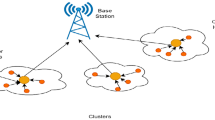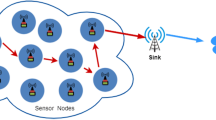Abstract
Many algorithms have been proposed in the area of Mobile Adhoc Networks that have been inspired from the behavior of nature inhabitated species such as ants, bees, termites and birds due to their decentralized and self configuring route search to their food. In this paper, a novel Ant Colony Inspired Energy efficient OLSR (AC-OLSR) routing protocol has been proposed. Link quality approach has been amalgamated while computing pheromone concentration which will improve network performance in a wireless scenario. Our proposed algorithm has been simulated on NS2 simulator and shows better performance as compared to existing routing protocols. The proposed approach has been compared with other existing proactive routing protocol such as Energy Efficient OLSR and AntNet routing protocol. In the proposed paper heuristic component while calculating pheromone concentration is also added to deterministic approaches using ETX metric of the link to further alleviate the performance of the network. It has been found that packet delivery ratio has been improved significantly in the proposed routing protocol because best path has been chosen over other paths considering lossless transmission in a wireless scenario. Although routing overhead of AC-OLSR is slightly higher but that can be compensated by reduced energy cost of the network.











Similar content being viewed by others
References
Guarnera, M., Villari, M., Zaia, A. and Puliafito, A. (2002). MANET: possible applications with PDA in wireless imaging environment. In The 13th IEEE International Symposium on Personal, Indoor and Mobile Radio Communications (Vol. 5, pp.2394–2398).
Anjum, S. S., Noor, R. M., & Anisi, M. H. (2017). Review on MANET based communication for search and rescue operations. Wireless Personal Communications, 94(1), 31–52.
Saeed, N. H., Abbod, M. F. and Al-Raweshidy, H. S. (2012). MANET routing protocols taxonomy. In 2012 International Conference on Future Communication Networks (pp. 123- 128).
Hinds, A., Ngulube, M., Zhu, S., & Al-Aqrabi, H. (2013). A review of routing protocols for mobile ad-hoc networks (manet). International Journal of Information and Education Technology, 3(1), 1–5.
Muthukumaran, N. (2017). Analyzing throughput of MANET with reduced packet loss. Wireless Personal Communications, 97(1), 565–578.
Muthurajkumar, S., Ganapathy, S., Vijayalakshmi, M., et al. (2017). An intelligent secured and energy efficient routing algorithm for MANETs. Wireless Personal Communication, 96, 1753–1769. https://doi.org/10.1007/s11277-017-4266-4
Rao, M., & Singh, N. (2018). Energy efficient QoS aware hierarchical KF-MAC routing protocol in Manet. Wireless Personal Communication, 101, 635–648. https://doi.org/10.1007/s11277-018-5708-3
Devi, V. S., & Hegde, N. P. (2018). Multipath security aware routing protocol for MANET based on trust enhanced cluster mechanism for lossless multimedia data transfer. Wireless Personal Communications, 100(3), 923–940.
Babu, M. R., & Usha, G. (2016). A novel honeypot based detection and isolation approach (NHBADI) to detect and isolate black hole attacks in MANET. Wireless Personal Communications, 90(2), 831–845.
Alameri, I. A. (2019). A Novel approach to comparative analysis of legacy and nature inspired ant colony optimization based routing protocol in MANET. Journal of Southwest Jiaotong University. https://doi.org/10.35741/issn.0258-2724.54.4.18
Nancharaiah, B. and Mohan, B. C. (2013). MANET link performance using ant colony optimization and particle swarm optimization algorithms. In 2013 International Conference on Communication and Signal Processing (pp. 767–770).
Kumar, R., Lokesh, S., & Devi, M. R. (2018). Identifying camouflaging adversary in MANET using cognitive agents. Wireless Personal Communications, 102(4), 3427–3441.
Mazhar, N., & Farooq, M. (2007). BeeAIS: artificial immune system security for nature inspired, MANET routing protocol BeeAdHoc. In L. N. de Castro, F. J. Von Zuben, & H. Knidel (Eds.), Artificial immune systems. ICARIS 2007. Lecture notes in computer science. (Vol. 4628). Springer. https://doi.org/10.1007/978-3-540-73922-7_32
Jain, R., & Kashyap, I. (2018). An efficient energy aware link stable routing protocol in MANETS. International Journal of Mechanical and Production Engineering Research and Development (IJMPERD), 8(3), 623–634.
Baskaran, R., Paul, P. V. and Dhavachelvan, P. (2013). Ant colony optimization for data cache technique in MANET. In Proceedings of International Conference on Advances in Computing (pp. 873–878). Springer, NewDelhi.
Jain, J., Gupta, R. and Bandhopadhyay, T. K., 2011, April. Ant colony algorithm in MANET- local link repairing of AODV. In 2011 3rd International Conference on Electronics Computer Technology (Vol. 6, pp. 270–273). IEEE.
Jain, R., & Kashyap, I. (2020). Energy-based improved MPR selection in OLSR routing protocol. In N. Sharma, A. Chakrabarti, & BalasV. (Eds.), Data management analytics and innovation. Advances in intelligent systems and computing. (Vol. 1042). Springer. https://doi.org/10.1007/978-981-32-9949-8_41
Eddine, B. S., Smail, O., Meftah, B., Rebbah, M., & Cousin, B. (2020). An efficient energy aware link stable multipath routing protocol for mobile Ad hoc networks in urban areas. Telfor Journal, 12(1), 2–7.
Jain, R., & Kashyap, I. (2019). An QoS aware link defined OLSR (LD-OLSR) routing protocol for MANETS. Wireless Personal Communication, 108, 1745–1758. https://doi.org/10.1007/s11277-019-06494-9
Ilango, M., Kumar, A. S. and Dutta, A. (2020). Binomial logistic regression resource optimized routing in MANET. In Evolutionary Computing and Mobile Sustainable Networks (pp. 387–398). Springer, Singapore.
Sathiamoorthy, J., & Ramakrishnan, B. (2017). Energy and delay efficient dynamic cluster formation using improved ant colony optimization algorithm in EAACK MANETs. Wireless Personal Communications, 95(2), 1531–1552.
Wang, J., Osagie, E., Thulasiraman, P., & Thulasiram, R. K. (2009). HOPNET: A hybrid ant colony optimization routing algorithm for mobile ad hoc network. Ad Hoc Networks, 7(4), 690–705.
Guleria, K., & Verma, A. K. (2019). Meta-heuristic ant colony optimization based unequal clustering for wireless sensor network. Wireless Personal Communications, 105(3), 891–911.
Khabbazian, M., & Bhargava, V. K. (2008). Localized broadcasting with guaranteed delivery and bounded transmission redundancy. IEEE Transactions on Computers, 57(8), 1072–1086.
Jain, R., & Kashyap, I. (2018). Experimental load analysis of AODV, OLSR in MANETS. IIOAB Journal, 9, 78–82.
Clausen, T. H., Jacquet, P. and Viennot, L. (2002). Investigating the impact of partial topology in proactive MANET routing protocols. In The 5th International Symposium on Wireless Personal Multimedia Communications (Vol. 3, pp.1374–1378).
Clausen, T., Dearlove, C. and Adamson, B. (2008). Jitter considerations in mobile ad hoc networks (MANETs).
Sharma, S., & Bhardwaj, S. K. (2015). Experimental analysis of olsr and dsdv protocols on ns-2.35 in mobile ad-hoc networks. International Journal of Computer Network and Information Security, 7(8), 21–29.
Clausen, T., Jacquet, P., Adjih, C., Laouiti, A., Minet, P., Muhlethaler, P., Qayyum, A. and Viennot, L. (2003). Optimized link state routing protocol (OLSR).
Ge, Y., Kunz, T. and Lamont, L. (2003). Quality of service routing in ad-hoc networks using OLSR. In 36th Annual Hawaii International Conference on System Sciences, 2003. Proceedings of the (pp. 9-pp).IEEE.
Acknowledgements
The author is highly thankful to Dr. Geetika Dhand and Dr. Kavita Sheoran of Maharaja Surajmal Institute of Technology, Janakpuri who have provided invaluable suggestions in reviewing this paper.
Funding
Not Applicable.
Author information
Authors and Affiliations
Corresponding author
Ethics declarations
Conflict of interest
The author declare that they have no conflict of interest.
Additional information
Publisher's Note
Springer Nature remains neutral with regard to jurisdictional claims in published maps and institutional affiliations.
Rights and permissions
About this article
Cite this article
Jain, R. Ant Colony Inspired Energy Efficient OLSR (AC-OLSR) Routing Protocol in MANETS. Wireless Pers Commun 124, 3307–3320 (2022). https://doi.org/10.1007/s11277-022-09514-3
Accepted:
Published:
Issue Date:
DOI: https://doi.org/10.1007/s11277-022-09514-3




